Task06:综合练习
练习一: 各部门工资最高的员工(难度:中等)
创建Employee 表,包含所有员工信息,每个员工有其对应的 Id, salary 和 department Id。

创建Department 表,包含公司所有部门的信息。
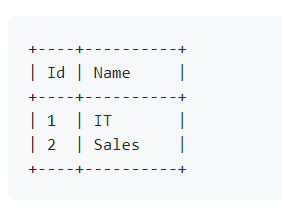
编写一个 SQL 查询,找出每个部门工资最高的员工。例如,根据上述给定的表格,Max 在 IT 部门有最高工资,Henry 在 Sales 部门有最高工资。

create table Employee(
Id int not null auto_increment,
Name varchar(8) not null,
Salary int not null,
Departmentid int not null,
primary key (Id));
insert into Employee (Name, Salary, Department) values ('Joe', 70000, 1);
insert into Employee (Name, Salary, Department) values ('Henry', 80000, 2);
insert into Employee (Name, Salary, Department) values ('Sam', 60000, 2);
insert into Employee (Name, Salary, Department) values ('Max', 90000, 1);
create table Department(
Id int not null auto_increment,
Name varchar(8) not null,
primary key (Id));
insert into Department (Name) values ('IT');
insert into Department (Name) values ('Sales');
select d.Name as Department, e.Name as Employee, e.Salary as Salary
from Department as d
join (select Name, Salary, DepartmentId from Employee as e1
where Salary = (select max(Salary) from Employee as e2
where e1.DepartmentId = e2.DepartmentId
group by e2.DepartmentId)) as e
on d.Id = e.DepartmentId
order by e.Salary desc;
练习二: 换座位(难度:中等)
小美是一所中学的信息科技老师,她有一张 seat 座位表,平时用来储存学生名字和与他们相对应的座位 id。
其中纵列的id是连续递增的
小美想改变相邻俩学生的座位。
你能不能帮她写一个 SQL query 来输出小美想要的结果呢?
请创建如下所示seat表:
示例:

假如数据输入的是上表,则输出结果如下:

注意: 如果学生人数是奇数,则不需要改变最后一个同学的座位。
create table seat(
id int not null auto_increment,
student varchar(8) not null,
primary key (id));
insert into seat (student) values ('Abbot');
insert into seat (student) values ('Doris');
insert into seat (student) values ('Emerson');
insert into seat (student) values ('Green');
insert into seat (student) values ('Jeames');
select (case when s.id % 2 = 0 then s.id - 1
when s.id % 2 != 0 and s.id != c.counts then s.id + 1
else s.id end) as id,
student
from seat as s, (select count(*) as counts from seat) as c
order by id;
练习三: 分数排名(难度:中等)
编写一个 SQL 查询来实现分数排名。如果两个分数相同,则两个分数排名(Rank)相同。请注意,平分后的下一个名次应该是下一个连续的整数值。换句话说,名次之间不应该有“间隔”。
创建以下score表:
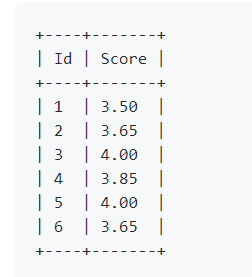
例如,根据上述给定的 Scores 表,你的查询应该返回(按分数从高到低排列):
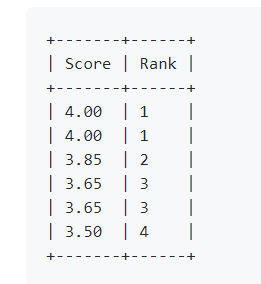
create table scores(
Id int not null auto_increment,
Score float not null,
primary key(Id));
insert into scores (Score) values (3.50);
insert into scores (Score) values (3.65);
insert into scores (Score) values (4.00);
insert into scores (Score) values (3.85);
insert into scores (Score) values (4.00);
insert into scores (Score) values (3.65);
-- 使用开窗函数
select Score, dense_rank() over(order by Score desc) as 'rank'
from scores;
-- 使用关联子查询
select s1.Score,
(select count(distinct s2.Score) from scores as s2
where s2.Score >= s1.Score) as 'rank'
from scores as s1
order by s1.Score desc;
练习四:连续出现的数字(难度:中等)
编写一个 SQL 查询,查找所有至少连续出现三次的数字。
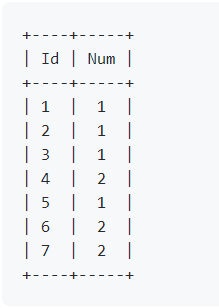
例如,给定上面的 Logs 表, 1 是唯一连续出现至少三次的数字。
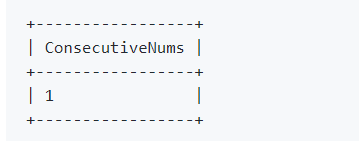
create table Logs(
Id int not null auto_increment,
Num int not null,
primary key(Id));
insert into Logs (Num) values (1);
insert into Logs (Num) values (1);
insert into Logs (Num) values (1);
insert into Logs (Num) values (2);
insert into Logs (Num) values (1);
insert into Logs (Num) values (2);
insert into Logs (Num) values (2);
select distinct s1.num as ConsecutiveNums from
(select *, row_number() over(order by id) - row_number() over(partition by num order by id) as uni
from logs) as s1
group by s1.num, s1.uni
having count(*) >= 3;
练习五:树节点 (难度:中等)
对于tree表,id是树节点的标识,p_id是其父节点的id。
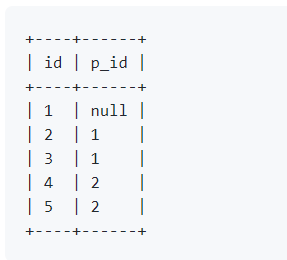
每个节点都是以下三种类型中的一种:
-
Root: 如果节点是根节点。
-
Leaf: 如果节点是叶子节点。
-
Inner: 如果节点既不是根节点也不是叶子节点。
写一条查询语句打印节点id及对应的节点类型。按照节点id排序。上面例子的对应结果为:
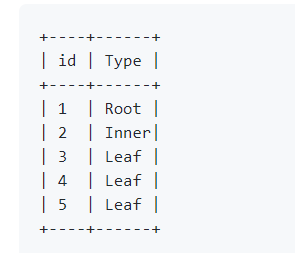
说明 -
节点’1’是根节点,因为它的父节点为NULL,有’2’和’3’两个子节点。
-
节点’2’是内部节点,因为它的父节点是’1’,有子节点’4’和’5’。
-
节点’3’,‘4’,'5’是叶子节点,因为它们有父节点但没有子节点。
下面是树的图形:
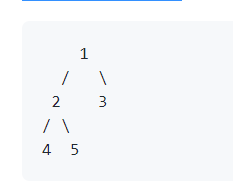
注意
如果一个树只有一个节点,只需要输出根节点属性。
create table tree(
id int not null auto_increment,
p_id int,
primary key (id));
insert into tree (p_id) values (null);
insert into tree (p_id) values (1);
insert into tree (p_id) values (1);
insert into tree (p_id) values (2);
insert into tree (p_id) values (2);
-- 使用case when
select id, (case when isnull(p_id) then 'Root'
when id in (select p_id from tree) then 'Inner'
else 'Leaf' end) as Type
from tree;
-- 使用if
select id, if(isnull(p_id), 'Root',
if(id in (select p_id from tree), 'Inner', 'Leaf')) as Type
from tree;
练习六:至少有五名直接下属的经理 (难度:中等)
Employee表包含所有员工及其上级的信息。每位员工都有一个Id,并且还有一个对应主管的Id(ManagerId)。
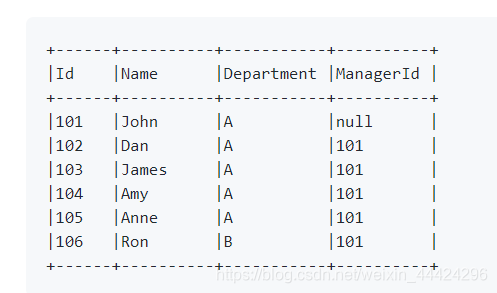
针对Employee表,写一条SQL语句找出有5个下属的主管。对于上面的表,结果应输出:
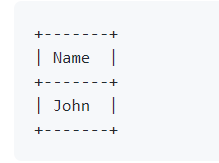
注意:
没有人向自己汇报。
create table Employee1(
Id int not null,
Name varchar(8) not null,
Department char(1) not null,
ManagerId int,
primary key (Id));
insert into Employee1 values (101, 'John', 'A', null);
insert into Employee1 values (102, 'Dan', 'A', 101);
insert into Employee1 values (103, 'James', 'A', 101);
insert into Employee1 values (104, 'Amy', 'A', 101);
insert into Employee1 values (105, 'Anne', 'A', 101);
insert into Employee1 values (106, 'Ron', 'B', 101);
select Name from Employee1
where Id in (select ManagerId from Employee1
group by ManagerId
having count(*) >= 5);
练习七: 分数排名 (难度:中等)
练习三的分数表,实现排名功能,但是排名需要是非连续的,如下:
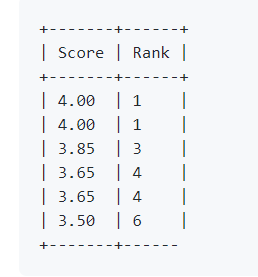
select Score, rank() over(order by Score desc) as 'rank' from scores;
练习八:查询回答率最高的问题 (难度:中等)
求出survey_log表中回答率最高的问题,表格的字段有:uid, action, question_id, answer_id, q_num, timestamp。
uid是用户id;action的值为:“show”, “answer”, “skip”;当action是"answer"时,answer_id不为空,相反,当action是"show"和"skip"时为空(null);q_num是问题的数字序号。
写一条sql语句找出回答率最高的问题。
举例:
输入

输出

问题285的回答率为1/1,然而问题369的回答率是0/1,所以输出是285。
注意:最高回答率的意思是:同一个问题出现的次数中回答的比例。
create table survey_log(
uid int not null,
action varchar(8) not null,
question_id int not null,
answer_id int,
q_num int not null,
timestamp int not null,
primary key(timestamp));
insert into survey_log values (5, 'show', 285, null, 1, 123);
insert into survey_log values (5, 'answer', 285, 124124, 1, 124);
insert into survey_log values (5, 'show', 369, null, 2, 125);
insert into survey_log values (5, 'skip', 369, null, 2, 126);
select question_id as survey_log
from (select question_id,
sum(case when action = 'answer' then 1 else 0 end) / sum(case when action = 'show' then 1 else 0 end) as ratio
from survey_log
group by question_id) as s
order by ratio desc
limit 1;
练习九:各部门前3高工资的员工(难度:中等)
将项目7中的employee表清空,重新插入以下数据(其实是多插入5,6两行):

编写一个 SQL 查询,找出每个部门工资前三高的员工。例如,根据上述给定的表格,查询结果应返回:

此外,请考虑实现各部门前N高工资的员工功能。
select d.Name as Department, e.Name as Employee, e.Salary
from (select e1.DepartmentId, e1.Name, e1.Salary
from (select *, rank() over (partition by DepartmentId order by Salary desc) as 'rank'
from employee) as e1
where e1.rank <= 3) as e
join Department as d
on e.DepartmentId = d.Id;
练习十:平面上最近距离 (难度: 困难)
point_2d表包含一个平面内一些点(超过两个)的坐标值(x,y)。
写一条查询语句求出这些点中的最短距离并保留2位小数。
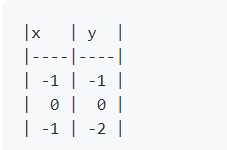
最短距离是1,从点(-1,-1)到点(-1,2)。所以输出结果为:
| shortest |
1.00
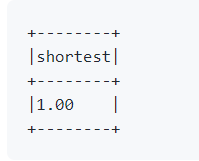
注意:所有点的最大距离小于10000。
create table point_2d (
x int not null,
y int not null,
primary key (x, y));
insert into point_2d values (-1, -1);
insert into point_2d values (0, 0);
insert into point_2d values (-1, -2);
select round(min(sqrt(power(p1.x - p2.x, 2) + power(p1.y - p2.y, 2))), 2) as shortest
from point_2d as p1, point_2d as p2
where p1.x != p2.x or p1.y != p2.y;
-- 效率高
select round(min(sqrt(power(p1.x - p2.x, 2) + power(p1.y - p2.y, 2))), 2) as shortest
from point_2d as p1, point_2d as p2
where p1.x < p2.x or (p1.x = p2.x and p1.y < p2.y);
练习十一:行程和用户(难度:困难)
Trips 表中存所有出租车的行程信息。每段行程有唯一键 Id,Client_Id 和 Driver_Id 是 Users 表中 Users_Id 的外键。Status 是枚举类型,枚举成员为 (‘completed’, ‘cancelled_by_driver’, ‘cancelled_by_client’)。

Users 表存所有用户。每个用户有唯一键 Users_Id。Banned 表示这个用户是否被禁止,Role 则是一个表示(‘client’, ‘driver’, ‘partner’)的枚举类型。

写一段 SQL 语句查出2013年10月1日至2013年10月3日期间非禁止用户的取消率。基于上表,你的 SQL 语句应返回如下结果,取消率(Cancellation Rate)保留两位小数。

create table Trips(
Id int not null auto_increment,
Client_Id int not null,
Driver_Id int not null,
City_Id int not null,
Status enum('completed','cancelled_by_driver','cancelled_by_client') not null,
Request_at date not null,
primary key(Id)
);
insert into Trips values (1, 1, 10, 1, 'completed', '2013-10-1');
insert into Trips values (2, 2, 11, 1, 'cancelled_by_driver', '2013-10-1');
insert into Trips values (3, 3, 12, 6, 'completed', '2013-10-1');
insert into Trips values (4, 4, 13, 6, 'cancelled_by_client', '2013-10-1');
insert into Trips values (5, 1, 10, 1, 'completed', '2013-10-2');
insert into Trips values (6, 2, 11, 6, 'completed', '2013-10-2');
insert into Trips values (7, 3, 12, 6, 'completed', '2013-10-2');
insert into Trips values (8, 2, 12, 12, 'completed', '2013-10-3');
insert into Trips values (9, 3, 10, 12, 'completed', '2013-10-3');
insert into Trips values (10, 4, 13, 12, 'cancelled_by_driver', '2013-10-3');
create table Users(
Users_Id int not null,
Banned enum('Yes', 'No') not null,
Role enum('client', 'driver') not null,
primary key(Users_Id)
);
insert into Users values (1, 'No', 'client');
insert into Users values (2, 'Yes', 'client');
insert into Users values (3, 'No', 'client');
insert into Users values (4, 'No', 'client');
insert into Users values (10, 'No', 'driver');
insert into Users values (11, 'No', 'driver');
insert into Users values (12, 'No', 'driver');
insert into Users values (13, 'No', 'driver');
select Request_at as Day,
round(sum(case when Status not like 'completed' then 1 else 0 end) / count(*), 2) as 'Cancellation Rate'
from (select * from Trips
where Client_Id in (select Users_Id
from Users
where Banned like 'No')
and Driver_Id in (select Users_Id
from Users
where Banned like 'No')) as s
where Request_at between '2013-10-01' and '2013-10-03'
group by Request_at;